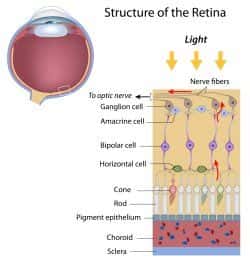While keratoconus can happen at any stage of life, young people between the ages of 10 and 25 are most likely to develop this disorder. For individuals with keratoconus, their cornea, the clear layer in the front of your eye, gradually thins and begins to bulge outward. Keratoconus typically causes nearsightedness
Read more
Retinal disorders are conditions that affect the layer of tissue at the back of the eye, known as the retina. This important part of the eye responds to light and passes on images to the brain. All retinal disorders affect your vision in some way, but some can also lead to blindness.
Macular degeneration. Also known as age-related macular degeneration (AMD), this condition affects the center part of the retina, the macula. This area is needed for the sharp, central vision that is used during everyday activities such as driving, reading or working with tools. This condition is a leading cause of vision loss in people over the age of 60 years old. Treatment can slow the loss of vision, but it will not restore vision that has already been lost.
Diabetic eye disease. The high blood sugar (glucose) levels that occur with diabetes can also affect vision. One type of diabetic eye disease is diabetic retinopathy, which affects the blood vessels in the retina. This can lead to blurry or double vision, blank spots in the vision and pain in one or both eyes. Diabetics may also be at higher risk of developing other eye conditions, such as cataracts and glaucoma.
Retinal detachment. This medical emergency happens when the retina pulls or lifts off of its normal position. It can cause symptoms such as floaters in the field of vision, light flashes and the feeling of a “curtain” in the way of your vision. If not treated right away, a retinal detachment can lead to permanent blindness in that eye.
Retinoblastoma. This cancer of the retina is generally uncommon; although, it is the most common type of eye cancer in children. The cancer starts in the cells of the retina, but can spread to other parts of the body (metastasize).
Macular pucker. Scar tissue on the macula can make the central vision become blurry and distorted. Although the symptoms are similar, macular pucker is not the same as age-related macular degeneration. The symptoms of a macular pucker are usually mild and do not require treatment. Sometimes, the scar tissue can fall off the retina on its own, and the vision will return to normal.
Macular hole. This condition is caused by a small break in the macula, which leads to blurriness and distortion in the central vision. Related to aging, this condition usually happens in people over the age of 60. Some macular holes close up on their own while others require surgery to help improve vision.
Floaters. These are specks, or “cobwebs,” that appear in the field of vision. Unlike scratches on the cornea, which follow your eye movements, floaters can drift even when the eyes are not moving. Most people have some floaters and have no problem with their vision. A sudden increase in the number of floaters, though, can indicate a more serious eye problem such as retinal detachment.
If you notice a change in your vision or simply have not undergone a routine eye ex
-
KeratoconusCategory: We Can Help With, Corneal Disorders, Disorders
-
VirusesCategory: We Can Help With, Corneal Disorders, Disorders
Herpes Zoster (Shingles) If you ever had chickenpox, you’re at higher risk of developing shingles later in life. Shingles can affect many parts of the body. If it travels to your eyes, your cornea can become inflamed and even scarred. Corneal damage might not be apparent until months after the shingles
Read more -
Corneal DystrophiesCategory: We Can Help With, Corneal Disorders, Disorders
This group of corneal disorders includes more than 20 variations. Each affects different parts of the cornea, causing it to get cloudy and compromising vision. Most of these dystrophies are inherited, affect both eyes equally and spread between layers of the cornea as they gradually progress.
Read more -
PterygiumCategory: We Can Help With, Corneal Disorders, Disorders
Pterygium is characterized by a pink tissue growth on the sclera (the white part of the eye), which seems to be the result of chronic exposure to ultraviolet light. In fact, because many surfers suffer from pterygium, the condition is often called surfer’s eye. Pterygium is not cancerous and may continue
Read more -
Stevens-Johnson SyndromeCategory: We Can Help With, Corneal Disorders, Disorders
This skin disorder, also called erythema multiforme major, sometimes causes painful lesions on the eyelids. Stevens-Johnson syndrome can cause painful corneal blisters and even holes, leading to vision loss.
Read more -
Iridocorneal Endothelial SyndromeCategory: We Can Help With, Corneal Disorders, Disorders
This syndrome most commonly affects women between 30 and 50 years old. Symptoms include changes to the iris, corneal swelling and the onset of glaucoma.
Read more -
Strabismus Causes and TreatmentCategory: We Can Help With, Adult Strabismus
In order for your eyes to focus normally, six muscles around each eye must work together. When your two eyes see different images, your brain tends to favor the stronger eye. This means the weak eye gets weaker, resulting in amblyopia, or “lazy eye.” Risk factors for developing strabismus may include
Read more -
Post-Concussive Vision SyndromeCategory: Visual Rehabilitation
More than 300,000 sports-related concussions occur each year, according to research. Many more concussions result from motor vehicle accidents, falls, and other non-sports related incidents. In addition to causing cognitive difficulties, concussions may result in a cluster of problems called post-concussive
Read more -
Special NeedsCategory: Visual Rehabilitation
The cognitive differences of special needs children and adults are well-documented, but vision issues often receive less attention. People with special needs have the same range of vision issues as their neurotypical counterparts; however, these vision problems occur at a much higher rate in special
Read more -
Traumatic InjuryCategory: Visual Rehabilitation
Accurate vision involves much more than good eye health. The brain integrates signals from the eyes with information from the motor, balance, and auditory systems to create an accurate view of the world. Following traumatic injury, one or more components of this complex system may be damaged. Receiving
Read more -
Balance BoardCategory: Vision Therapy Programs
The brain and the eyes work together to create a visual experience. On one hand, the eyes send signals to the brain, which allows it to translate that data into visuals; on the other, the brain sends signals to the muscles attached to each eye, controlling their movements. If anything disrupts these
Read more -
Corrective LensesCategory: Vision Therapy Programs
Corrective lenses are used to correct deviations, adjust focal points or neutralize other anomalies that impact the eyes’ ability to focus an image on the retina. To do this, the lenses must be the correct type and of the right power. Strength – which is expressed as diopeters – relies on the material
Read more -
Training DevicesCategory: Vision Therapy Programs
Visual-motor-sensory integration training uses various devices to appeal to a person’s senses, including touch, sound and smell. This type of therapy is particularly useful in children with autism. Devices may include play dough, rubber toys, weighted bells and blankets, water, rice, sand, beans, musical
Read more -
Cawthorne-Cooksey ExercisesCategory: Vision Therapy Programs
These exercises are mainly used at home and range from simple head and eye movements to performing more complex activities like throwing a ball or focusing on a stationary object while the head is moving. While moving one’s head and tossing a ball sounds easy enough, they are not simple tasks for persons
Read more -
Keep Your Eye on the Ball: How Vision Therapists Use Marsden Balls to Help Their PatientsCategory: Vision Therapy Programs
A Marsden ball might not look very impressive, but this little ball offers big benefits for athletes and children affected by strabismus, ambylopia and other conditions. Marsden ball exercises are just one of the techniques that vision therapists use to help patients make better use of their vision. What
Read more -
Electronic TargetsCategory: Vision Therapy Programs
Automated targets with timing mechanisms not only show the optometrist how the eyes move in the beginning of treatment – when eye problems have yet to be fully addressed – by strategically positioning the targets, but they give weak eyes a necessary workout. By moving the eyes around to focus on
Read more

